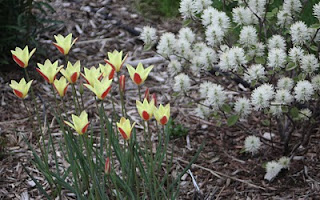It's Garden Bloggers Blooms Day. Thanks to Carol at
May Dreams Gardens for this meme.
Deep in the heart of Tulip. This is Hollandia (I think) from
Messelaar's Bulb Company. Look at the blues and greens that you miss if you just admire the tulip from the side.
If we're looking at Spring Plants this Bleeding Heart (Dicentra spectabilis) is still in full glory. It's a huge, well established plant that must be moved before the house gets painted. I'm going to try keeping it in a pot during the painting process and replanting it (in a different spot) after the painters are gone.
All of my violas and pansies are still going strong.
This is Centaurea montana Amethyst in Snow. A bit aggressive but I'd never seen anything like it before moving to New England. Now, of course, I've seen several varieties and I want the one with gold foliage and purple flowers. Not only do I really like golden or yellow-green foliage but that color with purple really hits my retinas the right way.
and now for something completely different. A Lewisia cotyledon. NOID on the variety. (sorry for the, uh, jarring contrast, just had to break up the string of purple flowers)
Chives. Yum.
Salvia nemerosa Viola Klaus - great variety, bloomed all summer last year.
A
quiligia alpina. My
Aquiligia canadensis Little Lantern is still blooming as well (another windy day on The Edge, my patience limits the picture taking. I can only spend so long with the camera focused waiting for the wind to die down and the plant to quit moving). I've grown
A. canadensis for years but lately lots of new varieties have been showing up in the garden centers. I'm starting to expand my
Aquiligia horizons. These are great, hardy little plants (yeah, they get leaf miners, so what, they don't look that bad and the leaf miners usually don't do that much damage!). There's a seed company in Britain called
Plant World Seeds that has even more varieties available as seeds, including some that are fragrant. I don't like growing from seeds (I'm not very good at it) but I think I'll make an exception for fragrant
Aquiligia!
Whew! A break from all the purple flowers. This tulip is Formosa (Gavota is in the back, a bit faded and nearly done). From
Brent and Becky's.
Armeria maritima (thrift) Rubrifolia. And friend.
Cornus hessei Garden Glow. This shrub doesn't have many flowers this year but I grow it for the foliage. Look at that color (and the mature leaves have a metallic sheen that I haven't been able to capture by camera) and it prefers SHADE. This one is really turning out to be a nice shrub.
Cute little Bellis perennis or lawn daisy or English daisy. Cute as a button. (Although, now that I think about it, I don't really find buttons to be cute. Functional yes, cute, not really. So let's change that to Cute as a Bug. What? I am a Biologist. I find Bugs cute!)
Wow. OK. Weird Flower. This is a Welsh Onion (Allium fistulosum). Welsh Onion is also known as Scallion or Spring Onion or Green Onion (the difference between those four terms is a bit murky so it may depend on your source). Another cooking plant that got mixed into the perennial gardens. And an odd flower to end on.
Not shown: Lots! It's starting to be that time of the year. I forgot to take notes while in the garden Friday so I can't recall them all off the top of my head. I'll try to remember to do that later and post an update (in between all the plant sales, the laying down of fresh mulch and the plantings I have to do. So, in other words not likely.)
Of note. I am down to ONE cyclamen indoors and it's starting to look ragged. Last weekend I composted the other cyclamen and my remaining primroses. All of these plants were bought during the winter to brighten the place up with their blooms. All of them are supposed to be short term plants that bloom for a brief while and get tossed. Mine lasted longer than expected (and will be composted) but I'm starting to need the room as my houseplants begin their spring growth spurts!









































